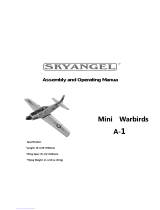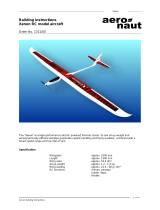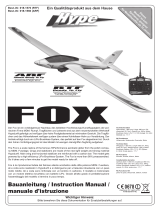
12
21. Installing the motor
Fix the motor to the motor bulkhead 38 using the screws
included in the power set. Install this assembly using the
screws 40, as shown in Fig. 27.
22. Installing the canopy latch catches
Fit the canopy 5 into the fuselage from the front, sliding it in
towards the wing, and only then push it down at the front. Fit
the two latch tongues 23 “dry”, and carefully position them
flush. Apply thick cyano to the serrated areas, then insert the
latch tongues into the slots in the canopy. Slide the canopy into
the fuselage, and allow the latch tongues to engage in the
latch catches 22. Immediately position the canopy accurately
on the fuselage while the glue is still wet. Wait for about one
minute before carefully opening the canopy again. Apply more
glue to the latch tongues if necessary.
Fig. 29
23. Installing the flight pack and receiver
The space for the flight battery is under the canopy, and extends
back under the wing saddle. Stick the strips of Velcro (hook-
and-loop) tape 20 / 21 in this area to secure the battery.
The speed controller fits in the side of the fuselage adjacent to
the flight pack. Install the receiver under the wing saddle, again
using the Velcro strips 20 / 21.
Fig. 30
Do not connect the battery to the speed controller unless
the transmitter is already switched on, and you are sure
that the throttle control is at the “OFF” position.
Connect the servo plugs to the receiver. Switch the transmitter
on, connect the flight battery to the speed controller, and the
controller to the receiver.
Now switch the motor on briefly so that you can check the
direction of rotation of the propeller (when checking the motor
be sure to hold the model securely, and remove any loose,
lightweight objects in front of and behind the model). If the
motor spins in the wrong direction, reverse two of the wires at
the motor - do not reverse the flight battery!
Caution: keep well clear of the propeller blades: serious injury
risk!
24. Deploying the aerial on the underside of the fuselage
The receiver aerial can be routed down and out of the
underside of the fuselage, and then deployed aft towards the
tail. You will need to pierce a hole through the fuselage floor,
working from the inside of the fuselage. Slip the aerial through
the hole from the inside, and fix it to the fuselage with a strip of
adhesive tape. If the aerial is longer (35 / 40 MHz), allow the
loose end to trail freely.
25. Setting the control surface travels
Setting the correct control surface travels is important if you
wish the model to respond to the control commands in a
balanced manner.
Up-elevator (stick back, towards you) 25 mm
Down-elevator (stick forward, away from you) 22 mm
Left rudder 25 mm
Right rudder 25 mm
Up-aileron 22 mm
Down-aileron 12 mm
The travels should always be measured at the widest part of
the control surface.
The control surface throws are not critical, and if you are unable
to set the exact stated travels using your transmitter’s
adjustment facilities, that’s no problem. If the discrepancy is
relatively great, you will need to re-connect the linkage using a
different hole at the horn or servo output arm.
If you intend to fly the model as a trainer, we recommend that
you reduce the control surface travels to about 50 - 60% of the
stated values.
26. Gilding the lily - applying the decals
The kit is supplied with a multi-colour decal sheet 2. Cut out
the individual name placards and emblems and apply them to
the model in the position shown in the kit box illustration, or in
an arrangement which you find pleasing. The decals cannot
be re-positioned once applied, so place them carefully!
27. Setting the Centre of Gravity
Like any other aircraft, the FunCub must be balanced at a
particular point in order to achieve stable flying characteristics.
Assemble your model ready to fly, and install the flight battery.
The Centre of Gravity (CG) should be at a position 80 mm aft
of the root leading edge, i.e. at the fuselage sides. Mark this
point on both sides of the fuselage.
Support the model at this position on two fingertips, and it
should balance level. If not, you can move the flight battery
forward or aft to correct the balance point. Once the correct
position is found, mark the location of the flight pack inside the
model to ensure that it is always replaced in the same position.
The CG location is not critical - 10 mm forward or aft of the
stated position presents no problems.
Fig. 31
28. Preparations for the first flight
Please wait for a day with as little breeze as possible for the
model’s initial test-flight. The evening hours are often ideal for
calm conditions.
Be sure to carry out a range check before the first flight,
using the procedure described in your RC system
instructions. If you encounter a problem, please don’t risk a
flight.
Send the whole system (including battery, switch harness and
servos) to the Service Department of your RC system
manufacturer and ask them to check it.
The first flight ...
The FunCub should always be launched exactly into any wind.
If you are a beginner to model flying we strongly recommend
that you ask an experienced model pilot to help you for the
first few flights.
29. Taking off from a hard strip
If you have access to a hard landing strip, a ground take-off is
always the safest option.
Once the model is test-flown you will be able to take off and
land from rough grass, i.e. without a mown strip - and precisely
that is the charm of this model.
30. Hand-launching
Please don’t try unpowered test-glides with this model - the
result is invariably a damaged airframe. The FunCub should
be hand-launched with the motor running at half-throttle, and
always pointing directly into wind.
Ask an experienced modeller to hand-launch your aircraft for
you.
The launcher should run forward for two or three paces, then









